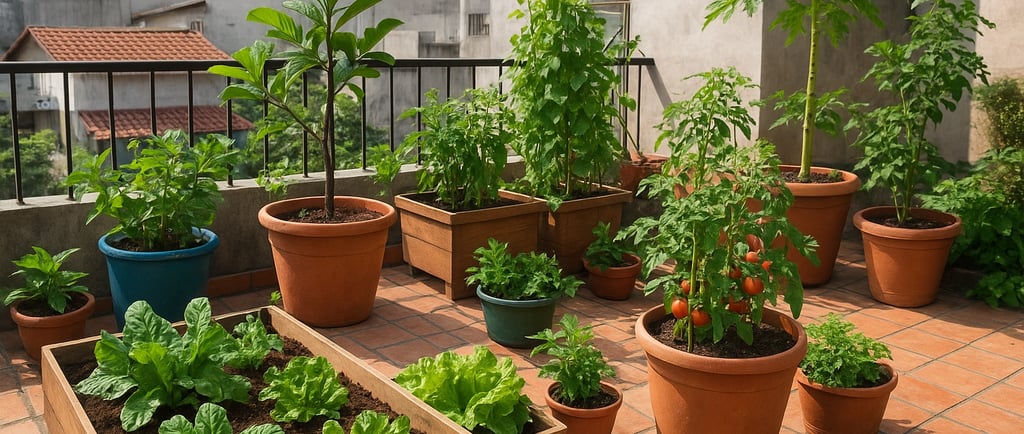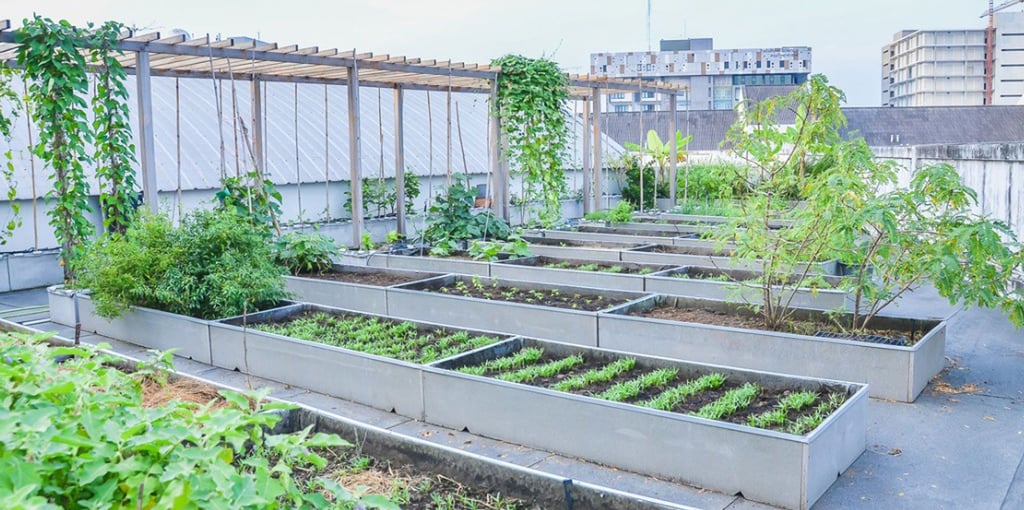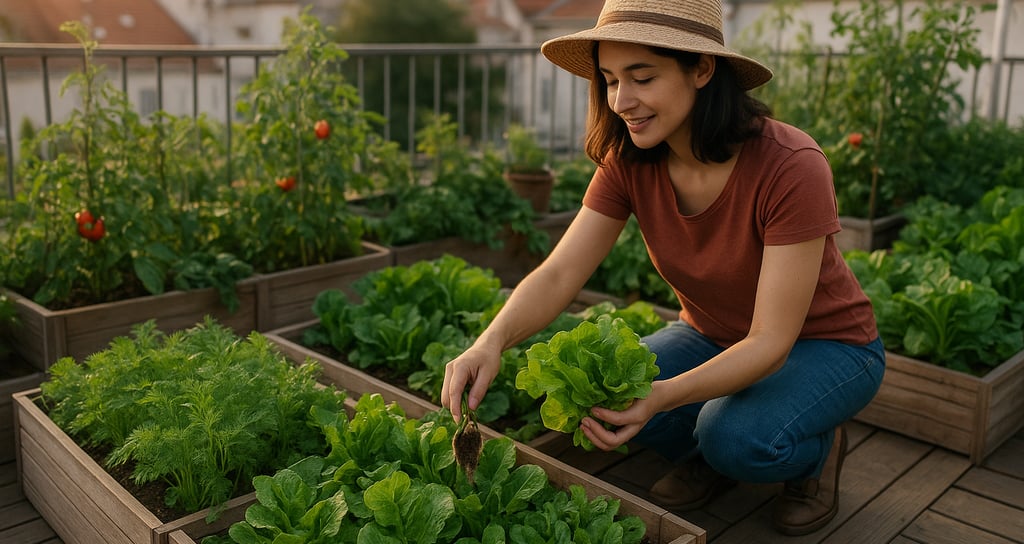Home Terrace Farming: Transform Your Space and Mind
Maintaining a successful home terrace farm requires both diligence and attention to detail. Central to effective terrace farming is establishing a regular watering schedule. Plants grown in pots or containers tend to dry out more quickly than those in traditional gardens, necessitating frequent checks on soil moisture.
SUSTAINABLE & ORGANIC FARMING
8/14/20258 min read


Introduction to Home Terrace Farming
Home terrace farming, often referred to as rooftop gardening, is the practice of cultivating plants on the terraces, balconies, or rooftops of residential buildings. This innovative approach to urban agriculture is gaining traction as city dwellers seek sustainable solutions to food production amid growing concerns about food security and environmental impact. In essence, home terrace farming transforms underutilized spaces into productive gardens where individuals can grow herbs, vegetables, and even fruits, creating green oases within dense urban settings.
The significance of terrace farming in today’s urban environments cannot be overstated. As cities expand and populations increase, the demand for fresh and locally sourced produce becomes more pronounced. Home terrace farming addresses this need by allowing residents to cultivate their own food, thus reducing reliance on store-bought products that often have extensive carbon footprints from transportation and packaging. Furthermore, by turning rooftops and balconies into productive spaces, individuals can contribute to the greening of urban areas, improving air quality and reducing the urban heat island effect.
Benefits of Home Terrace Farming
Home terrace farming presents numerous advantages that can profoundly impact both individual households and the environment. One of the primary benefits is the ability to cultivate fresh, chemical-free vegetables and fruits right at home. This localized approach to farming ensures that individuals have access to organic produce, reducing reliance on store-bought items often treated with pesticides and preservatives. By growing their food, families can enjoy healthier options while also relishing the satisfaction that comes from nurturing their own crops.
Additionally, home terrace farming can contribute to noticeable savings on grocery bills. As urban populations continue to grow, the cost of fresh produce can rise significantly. By producing their own fruits and vegetables, households can reduce their expenditures on food, enhancing financial stability. Moreover, the convenience of having homegrown produce readily available encourages healthier eating habits, as individuals are more likely to consume fresh items from their gardens.
Beyond personal benefits, home terrace farming has considerable environmental implications. The practice promotes improved air quality, as plants absorb carbon dioxide and release oxygen. Through the cultivation of greenery, urban areas can significantly lower pollution levels. Furthermore, home terrace farms combat the urban heat island effect, as plants help cool their surroundings and reduce the ambient temperature in densely populated locations.
Mental health benefits also arise from gardening activities. Engaging with plants can serve as a therapeutic outlet, reducing stress and promoting overall well-being. This connection to nature allows individuals to find tranquility amidst fast-paced urban lifestyles, fostering mindfulness and relaxation. Lastly, by utilizing unused space in urban environments, home terrace farming exemplifies sustainable living practices that optimize resource use while contributing positively to community ecosystems.
Planning Your Terrace Farm
Establishing a home terrace farm begins with careful planning, ensuring that both safety and productivity are prioritized. The first step is to assess the load-bearing capacity of your terrace. Evaluating how much weight your terrace can support is crucial, as it prevents potential structural damage or accidents. It is advisable to consult a professional if you are uncertain about your terrace's strength, especially if heavy soil or large planters will be used. This step can determine the size and scale of your terrace farm.
Next, the availability of sunlight should be considered meticulously. For optimal growth, most plants require a minimum of 4 to 6 hours of direct sunlight daily. Observe your terrace space throughout different times of the day to identify areas that receive ample sunlight and those that are shaded. Understanding this aspect will help you select appropriate crops that can thrive in the available light conditions, facilitating a successful harvest.
Another important aspect of planning is determining water access and drainage systems. Effective irrigation is vital for sustaining healthy plants in your terrace farm. Consider installing a drip irrigation system that conserves water while providing consistent moisture to your crops. Additionally, it is essential to ensure that your terrace has proper drainage to avoid water accumulation, which can lead to root rot and other plant diseases. Implementing containers with drainage holes or designing a sloped surface can enhance water management, creating a sustainable environment for your plants.
By addressing these key areas—load-bearing capacity, sunlight exposure, and water management—you can establish a well-structured home terrace farm that supports diverse plant life while enhancing your outdoor space.
Choosing the Right Crops for Your Terrace
When embarking on home terrace farming, one of the first and most crucial decisions is selecting the right crops to grow. The constraints of limited space mean that it is essential to choose plants that thrive in smaller environments while offering a plethora of benefits. Vegetables such as tomatoes, spinach, chilies, and brinjal are particularly well-suited for small-space gardening. They are generally compact in size, making them ideal candidates for terrace farming. Additionally, these vegetables are known for their versatility in various culinary applications, ensuring that homegrown produce can significantly enhance your meals.
Incorporating herbs into your terrace gardening can also be incredibly beneficial. Varieties like mint, coriander, and basil are not only easy to grow but also serve to elevate the flavor profile of many dishes. Their compact nature allows them to flourish alongside larger vegetable plants, maximizing available space. Furthermore, herbs often require less maintenance and can be harvested continually throughout their growing season, providing a steady supply for culinary uses.
To further optimize your terrace garden, consider practices such as crop rotation and companion planting. Crop rotation, which involves alternating the types of crops grown in each area over time, helps maintain soil fertility and can prevent pest infestations. Companion planting, on the other hand, takes advantage of the natural relationships between plants. Certain vegetables can benefit from being grown near specific herbs or other plants; for instance, planting basil near tomatoes is known to improve growth while repelling pests.
By thoughtfully selecting crops and utilizing effective gardening techniques, you can create a productive and vibrant terrace farm that contributes positively to your home and lifestyle.
Setting Up Your Terrace Garden
Establishing a successful terrace garden involves several practical steps that will enable you to maximize your available space for growing a variety of plants. The first decision revolves around selecting appropriate containers. Consider using lightweight materials such as plastic, wood, or metal to facilitate easy movement. Ensure that these containers have adequate drainage holes to prevent water logging, which can harm plant roots. Choosing pots of various sizes allows you to cultivate different plant types, from herbs to larger vegetables.
Next, the selection of soil is crucial for the success of your terrace garden. Opt for high-quality potting mix that retains moisture while providing good drainage. A mix of compost, vermiculite, and perlite can create the right texture for your plants, offering essential nutrients and aeration. Additionally, incorporating organic fertilizers can significantly enhance soil fertility, promoting robust plant growth.
Irrigation methods must also be thoughtfully considered. A drip irrigation system can be particularly effective for terrace gardens, ensuring consistent water supply without excessive waste. Alternatively, self-watering pots can alleviate the need for frequent watering while maintaining adequate moisture levels for your plants. Regular monitoring of moisture levels is key to a healthy terrace garden, as plants can suffer from both under- and over-watering.
Creating a microclimate is another important factor in your terrace garden's success. Positioning plants in a way that maximizes sunlight exposure and minimizes wind exposure will encourage optimal growth conditions. Grouping plants with similar water and sunlight requirements can streamline maintenance efforts. Additionally, utilizing vertical space through trellises or hanging gardens can enhance your gardening experience, enabling you to cultivate more plants in less space. Overall, thoughtful planning and organization will ensure a thriving terrace garden.
Maintaining Your Terrace Farm
Maintaining a successful home terrace farm requires both diligence and attention to detail. Central to effective terrace farming is establishing a regular watering schedule. Plants grown in pots or containers tend to dry out more quickly than those in traditional gardens, necessitating frequent checks on soil moisture. It is advisable to develop a watering routine that accommodates seasonal changes; during hot summer months, daily watering may be necessary, while cooler periods may allow for less frequent irrigation. Utilizing a drip irrigation system can also ensure consistent moisture levels and reduce water wastage.
Pest control is another crucial aspect of maintaining a terrace farm. Regular inspection of plants can help identify early signs of pest infestations. Natural solutions, such as neem oil or introducing beneficial insects, can effectively manage common pests without resorting to chemical pesticides. A diverse planting strategy, incorporating companion planting, can also deter harmful insects and promote overall plant health.
Pruning and harvesting at the appropriate times contribute significantly to the quality and yield of the crops. Regular pruning stimulates growth, enhances airflow, and prevents disease, especially in densely planted areas typical of terrace farming. Additionally, understanding the right times for harvesting ensures that crops are picked at their peak flavor and nutritional value. Each plant species has specific signs indicating readiness for harvest, so familiarizing oneself with these cues is beneficial.
Monitoring overall plant health is essential for catching any issues early on. Signs of distress may include yellowing leaves, stunted growth, or wilting, which could indicate problems such as nutrient deficiencies or a disease outbreak. Keeping detailed records of plant performance can help identify patterns and inform maintenance strategies. By staying proactive and observant, terrace farmers can cultivate a thriving urban oasis that not only provides food but also nourishes the mind.
Community Building and Sharing Your Harvest
Home terrace farming extends beyond the physical act of planting and harvesting; it fosters a sense of community among individuals who engage in this rewarding activity. Gardening on terraces can be a social catalyst that encourages interaction and collaboration among neighbors, friends, and family. When individuals share the fruits of their labor—literally—it can lead to stronger, more connected communities. The process of exchanging harvests creates opportunities for dialogue, cultural exchange, and mutual learning, reflecting the diverse backgrounds and gardening techniques of participants.
Participating in community-supported agriculture (CSA) initiatives is one effective way to enhance this communal experience. CSAs typically involve groups of local residents who support local farms by purchasing shares of the harvest in advance. This model not only helps sustain local agriculture but also builds a network of support among urban farmers. Members of a CSA often engage in events where they can share gardening tips, harvest recipes, and even success stories from their own terrace farming experiences. Such interactions ultimately promote environmental awareness and encourage more individuals to embrace sustainable practices.
Moreover, the rise of social media and online gardening groups further amplifies the reach of community engagement. These platforms provide a space to share photos of harvests, exchange advice, and celebrate gardening successes, creating a virtual community that transcends geographical boundaries. Online forums allow for collective problem-solving, where individuals can seek help for pest issues or plant diseases, thereby enhancing each member's gardening skills and knowledge. The shared experiences found in both physical and virtual spaces lead to an increased sense of belonging and commitment to sustainable gardening.
In this way, home terrace farming not only contributes to healthier lifestyles for individuals but also nurtures community spirit, paving the way for a sustainable urban environment characterized by cooperation and shared learning. This integration of social and agricultural practices not only enriches personal lives but also enhances the well-being of the entire neighborhood.




"Boosting Crop Growth With Nature's Power"
Contact Us:
E Mail: support@frosil.com
Customer Care: +91 8329592991
FROSIL © 2025. All rights reserved.


'Frosil' is a fertilizer manufacturer committed to enhancing soil health and crop yields. We provide high-quality, eco-friendly products that support sustainable agriculture and help farmers achieve optimal results.
Registered Office: Gat No.96, Near Krushnai Hospital, Tandali. Tal- Shirur, Dist- Pune.
